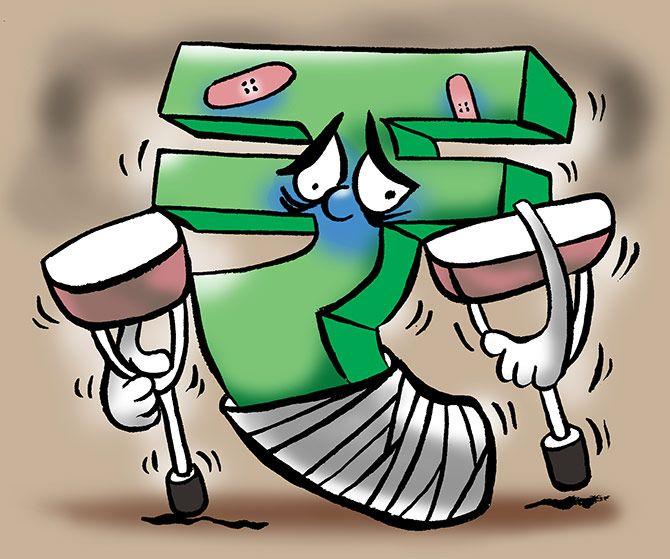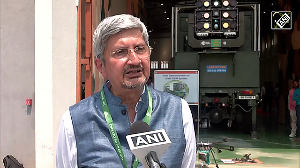'The rupee falling from 69 to 72 was not normal or justified by the fundamentals.'
'And therefore I treat this as temporary.'

"There seems to be some tug-of-war between those who believe the rupee, fundamentally, does not deserve to be at this level, and those who try to do some hedging or over-buying," Economic Affairs Secretary Subhash Chandra Garg tells Arup Roychoudhury and Indivjal Dhasmana.
There was a huge selloff in the markets on Friday, September 21. Your reaction?
I guess it was more of a reaction to some development which was not fully understood and there was a kind of an over-reaction.
And the market also corrected later on.
To my mind, this shows, to some extent, a bit of edginess and skittishness which is visible in the markets.
Some news came up which may not be of much import.
But the market tends to react in a certain way.
So this is some sign of the times.
Instead of reacting in such manner, investors should go by the strong underlying fundamentals rather than over-reacting to some news.
You say that the fundamentals are strong. But there are concerns on the external sector.
On current account deficit (CAD), let us look at the facts.
Last year it was 1.9 per cent of gross domestic product.
This year, we expect 2.8 to 2.9 per cent.
A 2 per cent CAD for a developing economy like India is a very strong thing to have.
All it represents is that this much equivalent capital transfers take place from international savings to national economy.
Two per cent is an accepted limited.
So if you exceed that by 1 per cent, in a $2.5 trillion economy, that means $25 billion.
If we are able to finance the CAD of $25 billion through the capital account, there is no problem.
Look at the fundamentals.
In the April-July quarter, the capital account was in surplus.
On a BoP basis, the deficit was only $11 billion.
We have large reserves and this, in Q1, happened when there was a $9 billion foreign portfolio investment outflow.
In the current quarter there are no outflows. The deficit may not be there, or may be very small.
If a deficit of $25 billion is additional on the current account, it makes sense to close that gap on the current account itself.
Everybody thinks that 1 per cent additional CAD is a problem.
So if we can resolve the problems in the current account itself, that is the best measure.
Hence the decisions. Then there was the announcement on curbing imports of non-essential items.
What the government is saying is anything essential for growth, requirement or consumption is not to be touched.
So we don't want capital imports or project imports.
But there are more than enough items on our list of imports in which the country has enough production and in which we are more than self-sufficient or those whose consumption is not very large.
If we can control them, it will be good for the economy.
What is your take on the level the rupee is at?
The rupee falling from 69 to 72 was not normal or justified by the fundamentals.
And therefore I treat this as temporary.
But this is the skittishness, edginess that I was talking about.
There seems to be some tug-of-war between those who believe the rupee, fundamentally, does not deserve to be at this level, and those who try to do some hedging or over-buying.
Soon to my mind, it will go back to a normal level.
What do you mean by a 'normal level'?
It doesn't make sense to have a number.
But what you should read is: When does the government start reacting?
This was when the rupee declined from 69 to 72.
In this range somewhere there is a discomfort zone.
And that is when you start reacting.
We announced those measures because we believe this is not the right level of the rupee.
At this point of time 69 to 70 should be more justified.
Will the RBI issue FCNR bonds?
The measures we have announced should be enough to close the current account gap.
I don't think there is a need for any other measure on the capital side.
However, the government and the RBI remain in a state of readiness.
If things deteriorate, we will take more measures.
I am not ruling out any capital measure.
Will external factors like the rupee and oil prices lead to fiscal trouble?
There can't be a clearer and more categorical statement than what the finance minister said.
The fiscal deficit target of 3.3 per cent of gross domestic product is inviolable.
Our performance has been on the dot for that period.
We don't see a possibility of the fiscal deficit being breached.
There are concerns regarding non tax revenues, including dividends from public sector units and spectrum, and the GST. What fallback options do you have?
Direct taxes are doing better than budgeted.
Non-tax revenues are doing very good -- we have collected Rs 1 trillion of the Rs 2.45 trillion targeted.
Last year, we had a shortfall of Rs 1 trillion from non-tax revenue, this year there will not be any shortfall.
But some PSUs say they won't pay any dividend...
That does not matter.
Last year too, SAIL did not pay any dividend.
So, all these calculations have been done.
There is speculation that the government mulling an expenditure advisory to rationalise administrative expenditure for the first time in many years. Is that true?
When we don't have any shortfall on the revenue side, where is the need for curbing expenditure?
Our expenditure programme has been going on very well this year.
Capital expenditure is around 44 per cent of the budget estimates.
However, the latest data shows that the Budget estimates for the revenue deficit have been breached till July. This is more worrisome than breaching the fiscal deficit. Don't you think so?
You don't have to go by monthly figures.
Our tax revenues are low in the first half.
Our expenditure, on the other hand, is higher.
We usually get 23 per cent of tax collection till July, while our expenditure is 35 per cent of the Budget Estimates.
So, there is a gap. But, our revenues go much higher than our expenditure in the second half.
We have not met the target of Rs 1 trillion GST collection a month except in April. So, are we looking at a huge shortfall in GST collection?
We are doing much better on direct taxes.
Taken together, we will be comfortable.
Finance Minister Arun Jaitley and you have said inflation is under control. But rising petroleum prices and the new procurement policy for agriculture produce will start affecting general prices. How do you see this and the monetary policy committee's meeting next month in this context?
The premise of inflation rates going up has been cited for a particular action.
But, you see the actual picture.
The retail price inflation rate stood at 3.69 per cent in August, lower than the mid-level of the target.
And oil prices have been played out in the August figure.
Are you concerned about the widening gap between bond yields and inflation?
Bond yields went up from 7.8 per cent about three weeks ago to 8.2 per cent last week (ending September 21).
They are now at 8.5 to 8.6 per cent.
Bond yields are higher than what would be justified by inflation and the government's fiscal deficit financing, according to my judgement.
This was due to a demand-supply gap here.
I am expecting these yields to come down.
The RBI has paid Rs 500 billion in its last fiscal year. Are you asking for more in the current financial year?
The RBI's half yearly accounts should be available by February.
If we have started a tradition of interim surplus distribution, there might be another distribution.
There is no question of asking or not asking.
This becomes part of the system.
How much will it be? Last year, the government asked for Rs 130 billion
Rs 130 billion was based on different arguments.
There was a Rs 430 billion surplus with the RBI.
The RBI had distributed Rs 300 billion.
Our case was that the entire Rs 430 billion should be reflected.
The RBI has moved to a formula-based transfer, where the board takes a view.













 © 2025
© 2025